Unit 1 Great scientists-Reading
文档属性
| 名称 | Unit 1 Great scientists-Reading | 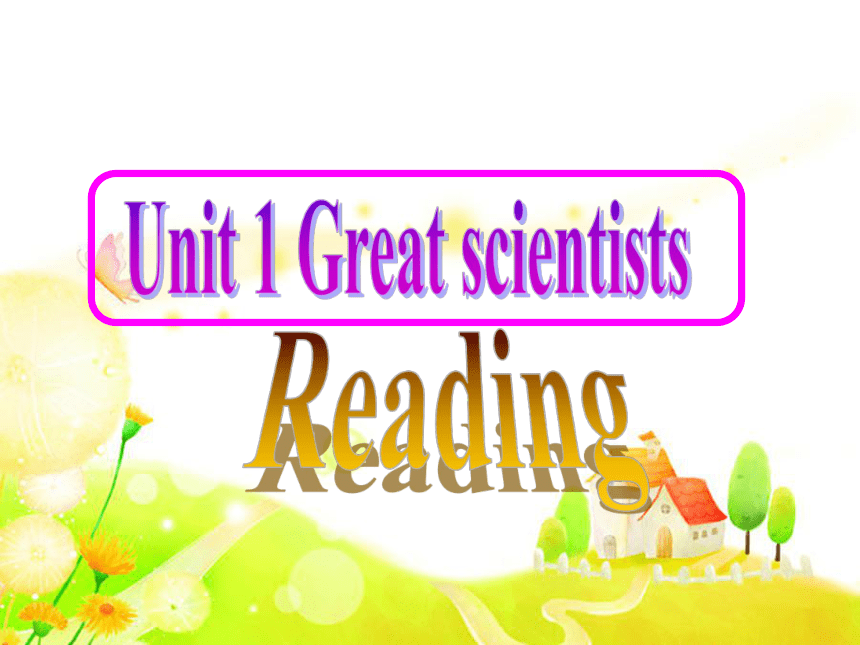 | |
| 格式 | rar | ||
| 文件大小 | 3.0MB | ||
| 资源类型 | 教案 | ||
| 版本资源 | 人教版(新课程标准) | ||
| 科目 | 英语 | ||
| 更新时间 | 2011-12-09 19:38:13 | ||
图片预览

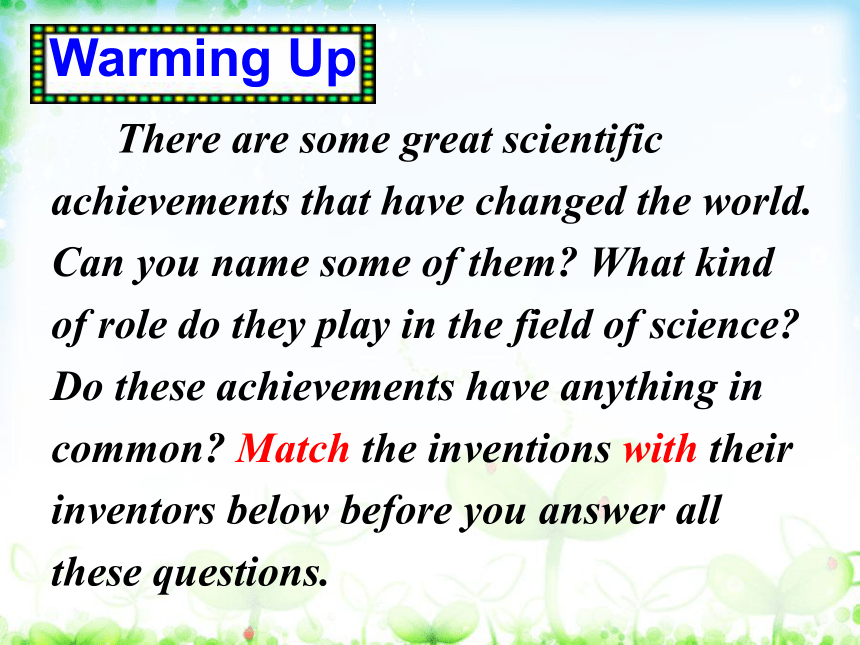
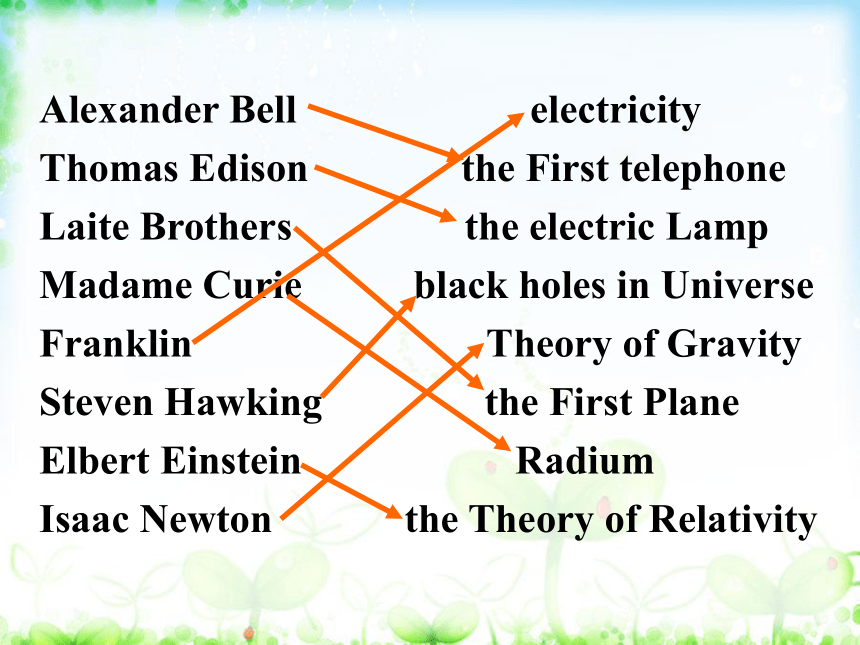
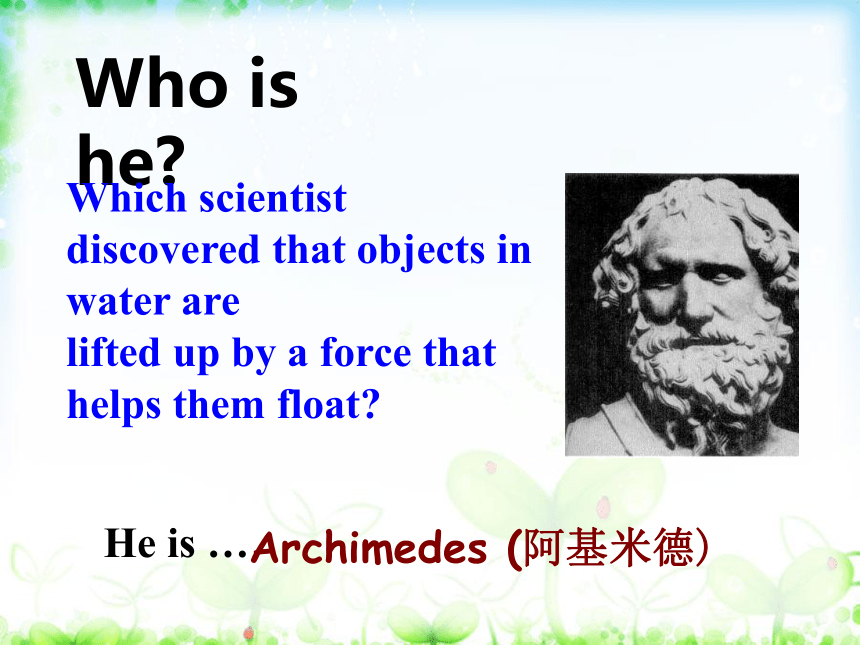
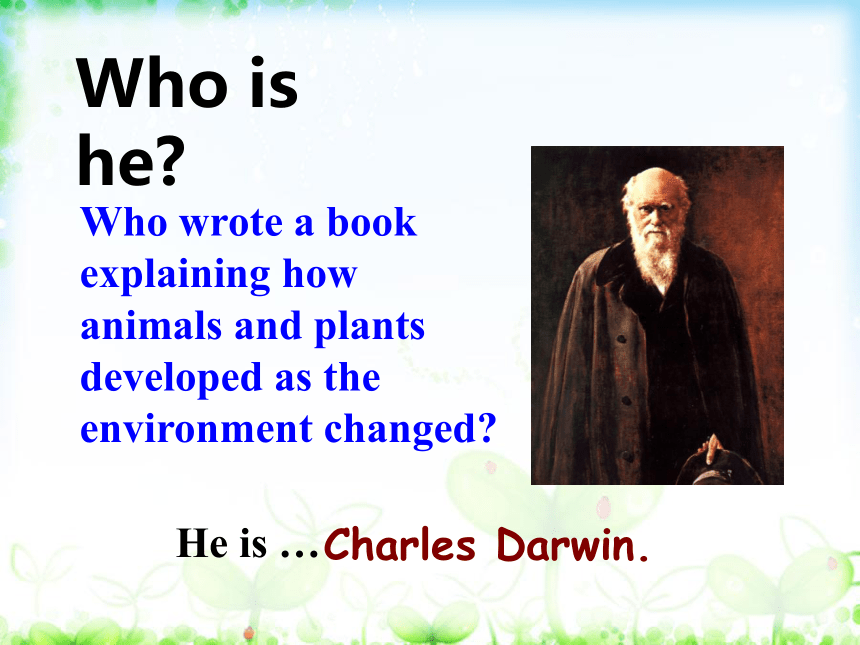

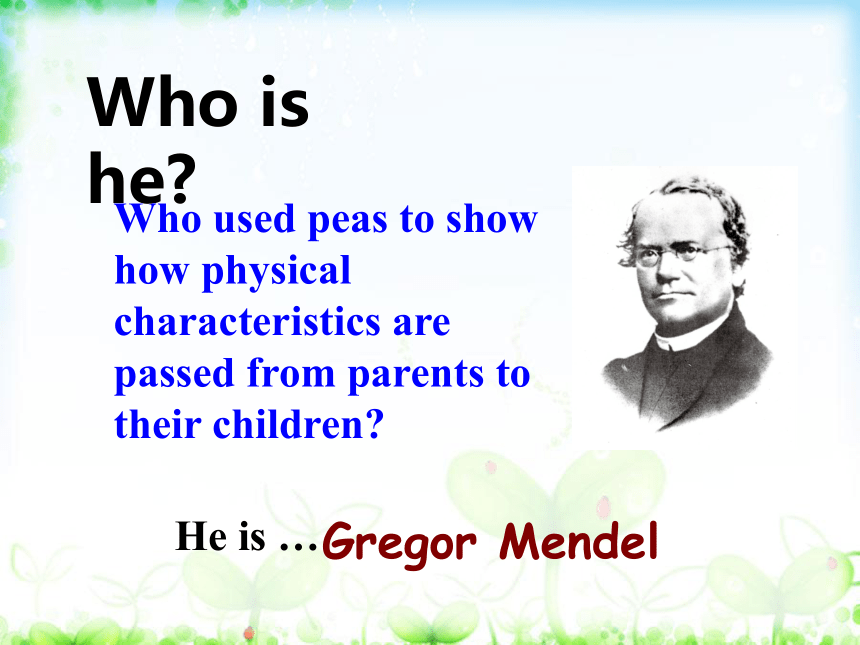
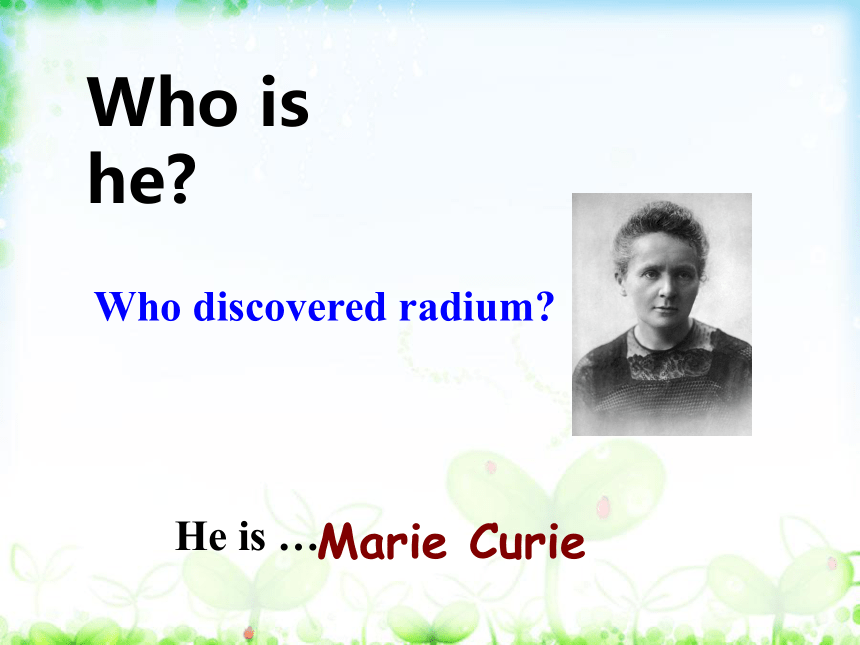
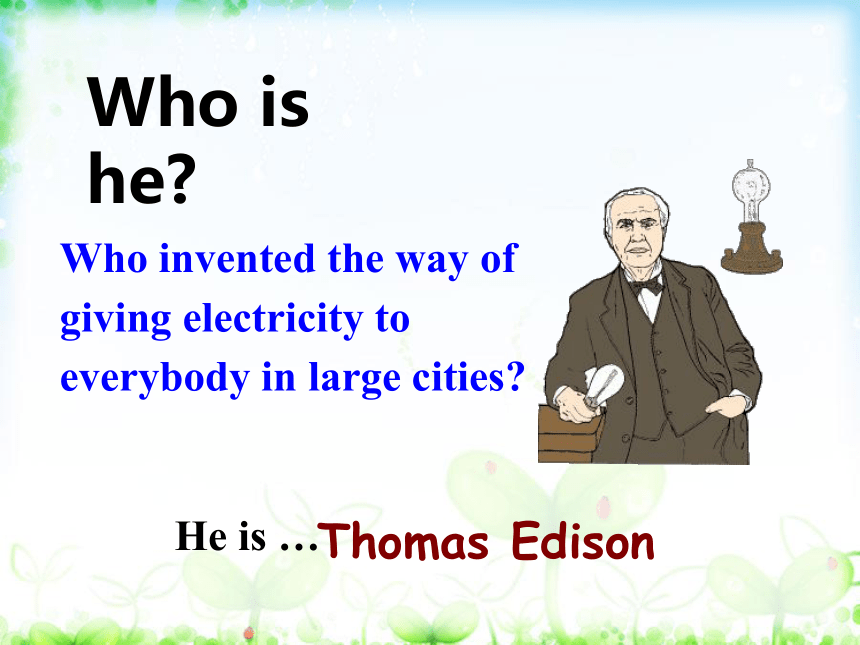
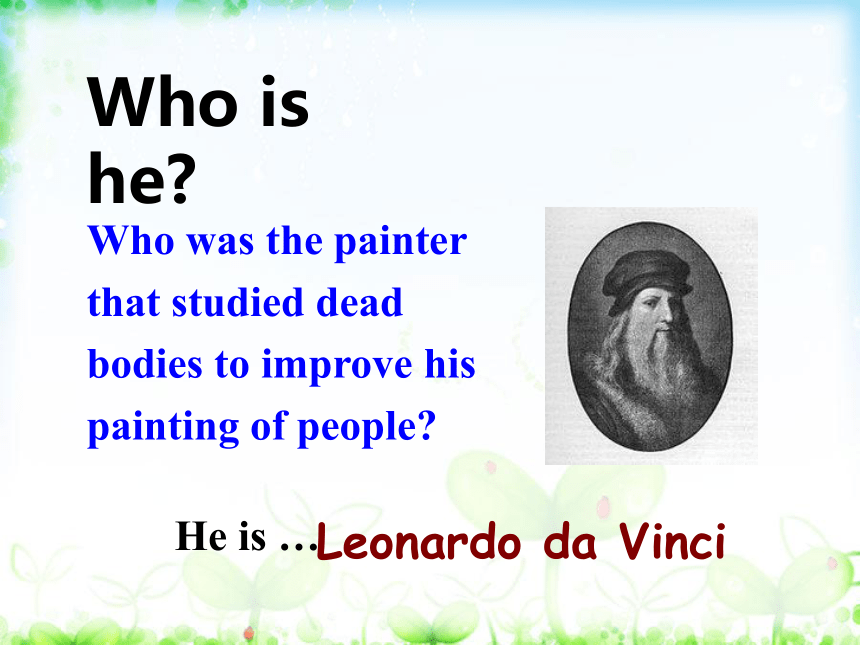
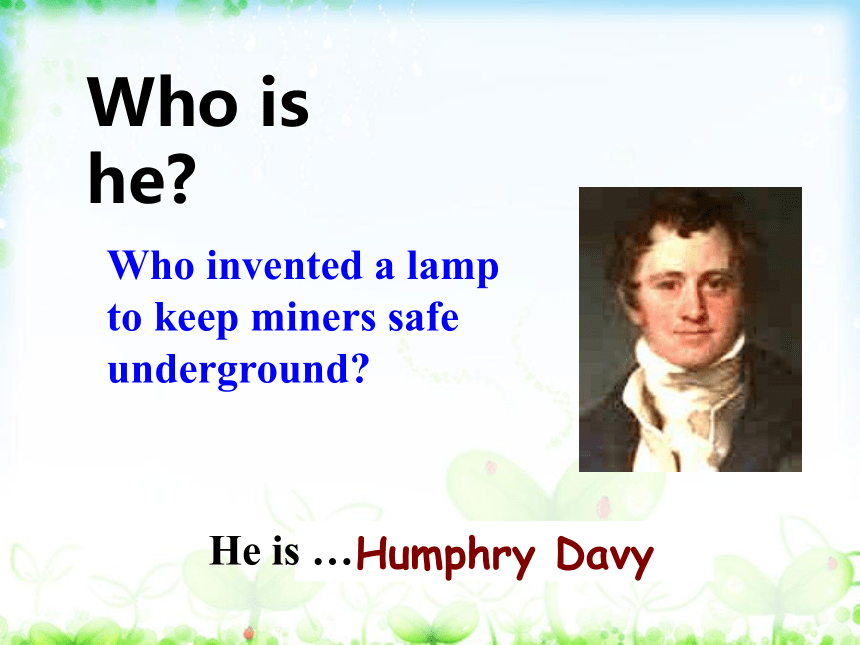
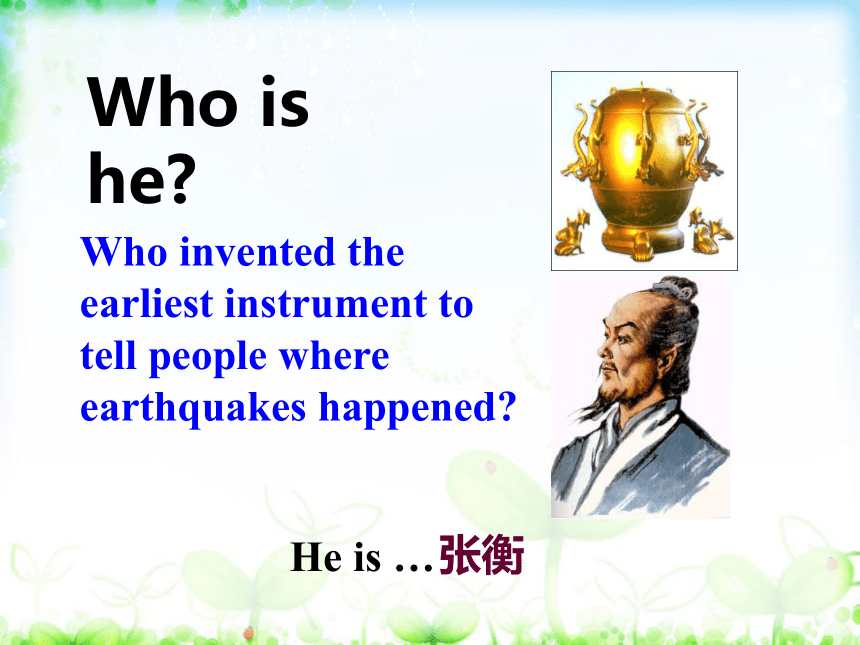
文档简介
(共55张PPT)
Warming Up
There are some great scientific achievements that have changed the world. Can you name some of them What kind of role do they play in the field of science Do these achievements have anything in common Match the inventions with their inventors below before you answer all these questions.
Alexander Bell electricity
Thomas Edison the First telephone
Laite Brothers the electric Lamp
Madame Curie black holes in Universe
Franklin Theory of Gravity
Steven Hawking the First Plane
Elbert Einstein Radium
Isaac Newton the Theory of Relativity
Who is he
He is …
Archimedes (阿基米德)
Which scientist discovered that objects in water are
lifted up by a force that helps them float
Charles Darwin.
Who is he
He is …
Who wrote a book explaining how animals and plants developed as the environment changed
Thomas Newcomen.
Who is he
He is …
Who invented the first steam engine
Gregor Mendel
Who is he
He is …
Who used peas to show how physical characteristics are passed from parents to their children
Marie Curie
Who is he
He is …
Who discovered radium
Thomas Edison
Who is he
He is …
Who invented the way of giving electricity to everybody in large cities
Leonardo da Vinci
Who is he
He is …
Who was the painter that studied dead bodies to improve his painting of people
Humphry Davy
Who is he
He is …
Who invented a lamp to keep miners safe underground
张衡
Who is he
He is …
Who invented the earliest instrument to tell people where earthquakes happened
Stephen Hawking
Who is he
He is …
Who put forward a theory about black holes
Lead-in
Supply the following words with detail.
John Snow
Cholera
John Snow
(1813-1858)
John Snow was born in York on March 15th, 1813, the oldest of nine children.
York
London
His father worked as a laborer. While poor, his parents were determined to give their children whatever educational opportunities they could afford. He was educated at a private school in his native city until the age of fourteen, when he was apprenticed(当学徒) to William Hardcastle, a surgeon(外科医生) living at Newcastle-on-Tyne.
After serving for a short time as a surgeon and unqualified assistant during the cholera epidemic of 1831-1982, he became in October 1836 a student at the Hunterian School of medicine in Great Windmill Street, London. He began to attend the medical practice at the Westminster Hospital in the following October.
1836
37
38
39
40
1845
41
42
43
44
He graduated M.D. of the University of London on 20 Dec. 1844, and in 1850 he was admitted a licentiate of the Royal College of Physicians.
He designed a chloroform inhaler(氯仿吸入器), described in his book, On Chloroform and other Anesthetics, published in 1858.
Dr. Snow was also a prominent anesthesiologist(麻醉师)
What else was he famous for
What is Cholera
Cholera is the illness caused by a bacterium called Vibria cholerae. It infects people’s intestines(肠), causing diarrhea(腹泻), vomiting(呕吐) and leg cramps(小腿抽筋).
The most common cause of cholera is by someone eating food or drinking water that has been contaminated with the
bacteria.
After a disaster, this is a very real danger, since regular, clean water and food supplies are often unavailable. The disease can be spread even further by infected people using already dirty water sources to clean themselves or dispose of waste.
Cholera can be mild or even without
symptoms, a severe case can lead to
death without immediate treatment. The
diarrhea and vomiting brought on by the
infection quickly leaves the body without
enough fluid. The following
dehydration(脱水) and shock can kill a
person within hours.
Look at the picture, the title and the map, guess what the content of the text is. Then skim it quickly to see if you are right.
When we want to solve some problem. First we should find the problem, do some research on it, prove your finding, and then make a conclusion. This is a scientific and objective way of researching.
1. What order would you put the seven in
Pre-reading
draw a conclusion
think of a method
collect results
make a question
find a problem
analyse the results
Find supporting evidence
Please put the
7 stages in right order according to the passage.
Infectious diseases can be spread to
other people. They have an unknown
cause and need public health care to
solve them.
2. What do you know about infectious diseases
Repel (回避) may be exposed to an infectious diseases, so may animals, such as bird flu. AIDS, SARS are infectious diseases.
Infectious diseases are difficult to cure.
Cholera is the illness caused by a bacterium called Varian cholera. If infects people’s intestines(肠胃), causing diarrhea(腹泻), vomiting(呕吐) and leg cramps (小腿抽筋).
3. What do you know about cholera
The most common cause of cholera is by someone eating food or drinking water that has been contaminated(污染) with the bacteria.
Cholera can be mild(不严重的) or
even without symptoms(症状), but a
severe case can lead to death without
immediately treatment.
Germany
Great Britain
Death of first cholera case in London during the 1848-49 epidemic
London
Previous cholera epidemic in Great Britain in 1831-32
The spread of cholera
John Snow Defeats “King Cholera”
What is the problem
Cholera was the deadly disease of its day. Neither its cause nor its cure
was understood.
What’s the cause of cholera
Make a question: two theories
1. Cholera multiplied in the air.
A cloud of dangerous gas floated
around until it found its victims.
2. People absorbed it with their meals.
Broad Street
Many deaths happened here.
No death happened here.
The water from the pump was to blame.
Public house
Small, white, flocculent particles
The water was from the river
which had been polluted by
the dirty water from London.
Find supporting evidence: What extra evidence did he find
A woman and her daughter who lived far away but drank the water also died.
Draw a conclusion with certainty
The polluted water
carried the virus.
I. Read the text carefully and fill in the blanks.
Many people died of cholera.
John Snow tried to find out its _____ and ____
People drank water from the pump in ______ Street.
Most died.
cause
cure
Broad
Comprehending
Families were given free beer in the pub at __________ Street.
People removed the ______ from the water pump.
People had no ________
The disease ___________
Cambridge
deaths
handle
slowed down
_______ water carried the disease.
Theory 2 that people ________ the disease with their meals proved right. And theory 1 was wrong.
________ the source of all the water supplies.
Polluted
absorbed
Examine
II. True (T) or false (F):
1. Cholera would never be controlled even if its cause was found.
2. The disease attacked the body quickly from the stomach and soon the affected person died.
3. John Snow began to collect the information before the disease spread.
F
T
F
4. In two particular streets, 500 people died in 10 days when another outbreak hit London in 1854.
5. Deaths of the woman and her daughter were linked to the Broad Street outbreak.
6. Only ordinary people died when cholera broke out.
F
T
F
III. Choose the best answers.
1. What’s the purpose of the text
A. To show us how difficult it was to find a cure for cholera.
B. To tell us how John Snow found the cause of cholera and the cure for it.
C. To show us how difficult it was to carry out experiments at that time.
D. To tell us the way cholera spread and how serious it was.
2. What inspired John Snow according to the first paragraph
Being Queen Victoria’s personal
physician.
B. Finding where cholera happened.
C. Helping ordinary people who suffered
from cholera.
3. What’s the use of John Snow’s map in his research
To help him find the number of dead
people.
B. To help him not lose his way.
C. To help him find the reason of the
cholera outbreak.
4. Which of the following is TRUE according to the text
A. John Snow became famous after cholera hit England in the 19th century.
B. John Snow began to collect information long before cholera hit England in the 19th century.
C. The mother and her daughter mentioned in the text both lived in Broad Street.
D. John Snow felt unsure about the cause of cholera after he finished the map.
5. Why was cholera called “King Cholera” in the text
A. Because cholera caused many deaths.
B. Because it got its name from Queen Victoria.
C. Because cholera was the most deadly disease of its day.
D. Because it was defeated with the help of the king.
6. Another title of the text might be ______.
John Snow and cholera
The discovery of cholera
C. John Snow: a great scientist
What should you do if you're travelling to a country that has a cholera outbreak
Drink only water that you have boiled
or treated with chlorine or iodine. Other
safe drinks include tea or coffee made
with boiled water and carbonated, bottled
beverages with no ice.
Eat only food that's been thoroughly cooked and is still hot, or fruit that you've peeled yourself.
Avoid undercooked or raw fish and shellfish.
Avoid raw salads and vegetables.
Avoid food and drinks from street vendors.
"Boil it, cook it, peel it, or forget it."
TIPS
Group Discussion
1. John Snow believed Idea 2 was right. How did he finally prove it
John Snow finally proved his idea because he found an outbreak that was clearly related to cholera, collected information and was able to tie cases outside the area to the polluted water.
2. Do you think John Snow would have solved this problem without the map
No. The map helped John Snow organize his ideas. He was able to identify those households that had had many deaths and check their water-drinking habits. He identified those houses that had had no deaths and surveyed their drinking habits. The evidence clearly pointed to the polluted water being the cause.
3. Cholera is a 19th century disease. What disease do you think is similar to cholera today
Two diseases, which are similar today, are SARS and AIDS because they are both serious, have an unknown cause and need public health care to solve them.
Warming Up
There are some great scientific achievements that have changed the world. Can you name some of them What kind of role do they play in the field of science Do these achievements have anything in common Match the inventions with their inventors below before you answer all these questions.
Alexander Bell electricity
Thomas Edison the First telephone
Laite Brothers the electric Lamp
Madame Curie black holes in Universe
Franklin Theory of Gravity
Steven Hawking the First Plane
Elbert Einstein Radium
Isaac Newton the Theory of Relativity
Who is he
He is …
Archimedes (阿基米德)
Which scientist discovered that objects in water are
lifted up by a force that helps them float
Charles Darwin.
Who is he
He is …
Who wrote a book explaining how animals and plants developed as the environment changed
Thomas Newcomen.
Who is he
He is …
Who invented the first steam engine
Gregor Mendel
Who is he
He is …
Who used peas to show how physical characteristics are passed from parents to their children
Marie Curie
Who is he
He is …
Who discovered radium
Thomas Edison
Who is he
He is …
Who invented the way of giving electricity to everybody in large cities
Leonardo da Vinci
Who is he
He is …
Who was the painter that studied dead bodies to improve his painting of people
Humphry Davy
Who is he
He is …
Who invented a lamp to keep miners safe underground
张衡
Who is he
He is …
Who invented the earliest instrument to tell people where earthquakes happened
Stephen Hawking
Who is he
He is …
Who put forward a theory about black holes
Lead-in
Supply the following words with detail.
John Snow
Cholera
John Snow
(1813-1858)
John Snow was born in York on March 15th, 1813, the oldest of nine children.
York
London
His father worked as a laborer. While poor, his parents were determined to give their children whatever educational opportunities they could afford. He was educated at a private school in his native city until the age of fourteen, when he was apprenticed(当学徒) to William Hardcastle, a surgeon(外科医生) living at Newcastle-on-Tyne.
After serving for a short time as a surgeon and unqualified assistant during the cholera epidemic of 1831-1982, he became in October 1836 a student at the Hunterian School of medicine in Great Windmill Street, London. He began to attend the medical practice at the Westminster Hospital in the following October.
1836
37
38
39
40
1845
41
42
43
44
He graduated M.D. of the University of London on 20 Dec. 1844, and in 1850 he was admitted a licentiate of the Royal College of Physicians.
He designed a chloroform inhaler(氯仿吸入器), described in his book, On Chloroform and other Anesthetics, published in 1858.
Dr. Snow was also a prominent anesthesiologist(麻醉师)
What else was he famous for
What is Cholera
Cholera is the illness caused by a bacterium called Vibria cholerae. It infects people’s intestines(肠), causing diarrhea(腹泻), vomiting(呕吐) and leg cramps(小腿抽筋).
The most common cause of cholera is by someone eating food or drinking water that has been contaminated with the
bacteria.
After a disaster, this is a very real danger, since regular, clean water and food supplies are often unavailable. The disease can be spread even further by infected people using already dirty water sources to clean themselves or dispose of waste.
Cholera can be mild or even without
symptoms, a severe case can lead to
death without immediate treatment. The
diarrhea and vomiting brought on by the
infection quickly leaves the body without
enough fluid. The following
dehydration(脱水) and shock can kill a
person within hours.
Look at the picture, the title and the map, guess what the content of the text is. Then skim it quickly to see if you are right.
When we want to solve some problem. First we should find the problem, do some research on it, prove your finding, and then make a conclusion. This is a scientific and objective way of researching.
1. What order would you put the seven in
Pre-reading
draw a conclusion
think of a method
collect results
make a question
find a problem
analyse the results
Find supporting evidence
Please put the
7 stages in right order according to the passage.
Infectious diseases can be spread to
other people. They have an unknown
cause and need public health care to
solve them.
2. What do you know about infectious diseases
Repel (回避) may be exposed to an infectious diseases, so may animals, such as bird flu. AIDS, SARS are infectious diseases.
Infectious diseases are difficult to cure.
Cholera is the illness caused by a bacterium called Varian cholera. If infects people’s intestines(肠胃), causing diarrhea(腹泻), vomiting(呕吐) and leg cramps (小腿抽筋).
3. What do you know about cholera
The most common cause of cholera is by someone eating food or drinking water that has been contaminated(污染) with the bacteria.
Cholera can be mild(不严重的) or
even without symptoms(症状), but a
severe case can lead to death without
immediately treatment.
Germany
Great Britain
Death of first cholera case in London during the 1848-49 epidemic
London
Previous cholera epidemic in Great Britain in 1831-32
The spread of cholera
John Snow Defeats “King Cholera”
What is the problem
Cholera was the deadly disease of its day. Neither its cause nor its cure
was understood.
What’s the cause of cholera
Make a question: two theories
1. Cholera multiplied in the air.
A cloud of dangerous gas floated
around until it found its victims.
2. People absorbed it with their meals.
Broad Street
Many deaths happened here.
No death happened here.
The water from the pump was to blame.
Public house
Small, white, flocculent particles
The water was from the river
which had been polluted by
the dirty water from London.
Find supporting evidence: What extra evidence did he find
A woman and her daughter who lived far away but drank the water also died.
Draw a conclusion with certainty
The polluted water
carried the virus.
I. Read the text carefully and fill in the blanks.
Many people died of cholera.
John Snow tried to find out its _____ and ____
People drank water from the pump in ______ Street.
Most died.
cause
cure
Broad
Comprehending
Families were given free beer in the pub at __________ Street.
People removed the ______ from the water pump.
People had no ________
The disease ___________
Cambridge
deaths
handle
slowed down
_______ water carried the disease.
Theory 2 that people ________ the disease with their meals proved right. And theory 1 was wrong.
________ the source of all the water supplies.
Polluted
absorbed
Examine
II. True (T) or false (F):
1. Cholera would never be controlled even if its cause was found.
2. The disease attacked the body quickly from the stomach and soon the affected person died.
3. John Snow began to collect the information before the disease spread.
F
T
F
4. In two particular streets, 500 people died in 10 days when another outbreak hit London in 1854.
5. Deaths of the woman and her daughter were linked to the Broad Street outbreak.
6. Only ordinary people died when cholera broke out.
F
T
F
III. Choose the best answers.
1. What’s the purpose of the text
A. To show us how difficult it was to find a cure for cholera.
B. To tell us how John Snow found the cause of cholera and the cure for it.
C. To show us how difficult it was to carry out experiments at that time.
D. To tell us the way cholera spread and how serious it was.
2. What inspired John Snow according to the first paragraph
Being Queen Victoria’s personal
physician.
B. Finding where cholera happened.
C. Helping ordinary people who suffered
from cholera.
3. What’s the use of John Snow’s map in his research
To help him find the number of dead
people.
B. To help him not lose his way.
C. To help him find the reason of the
cholera outbreak.
4. Which of the following is TRUE according to the text
A. John Snow became famous after cholera hit England in the 19th century.
B. John Snow began to collect information long before cholera hit England in the 19th century.
C. The mother and her daughter mentioned in the text both lived in Broad Street.
D. John Snow felt unsure about the cause of cholera after he finished the map.
5. Why was cholera called “King Cholera” in the text
A. Because cholera caused many deaths.
B. Because it got its name from Queen Victoria.
C. Because cholera was the most deadly disease of its day.
D. Because it was defeated with the help of the king.
6. Another title of the text might be ______.
John Snow and cholera
The discovery of cholera
C. John Snow: a great scientist
What should you do if you're travelling to a country that has a cholera outbreak
Drink only water that you have boiled
or treated with chlorine or iodine. Other
safe drinks include tea or coffee made
with boiled water and carbonated, bottled
beverages with no ice.
Eat only food that's been thoroughly cooked and is still hot, or fruit that you've peeled yourself.
Avoid undercooked or raw fish and shellfish.
Avoid raw salads and vegetables.
Avoid food and drinks from street vendors.
"Boil it, cook it, peel it, or forget it."
TIPS
Group Discussion
1. John Snow believed Idea 2 was right. How did he finally prove it
John Snow finally proved his idea because he found an outbreak that was clearly related to cholera, collected information and was able to tie cases outside the area to the polluted water.
2. Do you think John Snow would have solved this problem without the map
No. The map helped John Snow organize his ideas. He was able to identify those households that had had many deaths and check their water-drinking habits. He identified those houses that had had no deaths and surveyed their drinking habits. The evidence clearly pointed to the polluted water being the cause.
3. Cholera is a 19th century disease. What disease do you think is similar to cholera today
Two diseases, which are similar today, are SARS and AIDS because they are both serious, have an unknown cause and need public health care to solve them.
